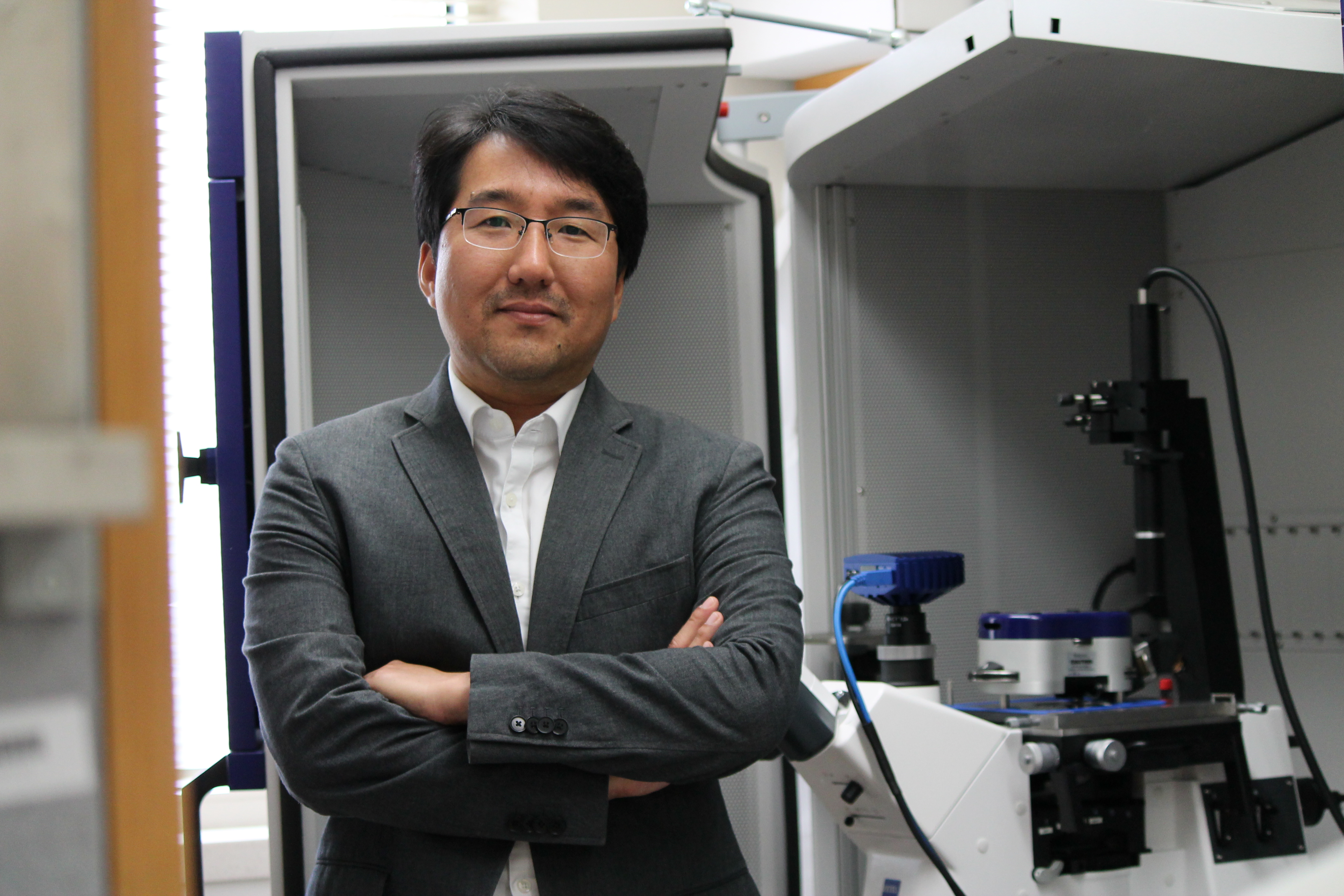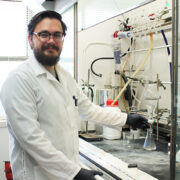
6
December

School of Pharmacy researchers in fiscal year 2021–22 received four patents for innovations in drug discovery and delivery
By Jill Sakai
The University of Wisconsin–Madison’s longstanding commitment to discovery and innovative scholarship shines through in its continuing success in a variety of research rankings, including the number of patents awarded to its scholars.
Patents awarded to UW–Madison researchers reflect the creativity and discoveries that are the foundation of the new processes, technologies, and products that fuel the university’s research enterprise. Each year, the Wisconsin Alumni Research Foundation — which manages intellectual property for UW–Madison — ranks highly among the top universities worldwide granted U.S. utility patents by the U.S. Patent and Trademark Office. In 2021, the National Academy of Inventors and Intellectual Property Owners Association ranked WARF and the University of Wisconsin at 12th globally, with a total of 143 patents.
School of Pharmacy faculty, staff, and students received four patents in fiscal year 2021–22 for developments in drug discovery and delivery. Such innovations are at the core of the School’s mission to advance patient care through research, education, and service in pharmaceutical, social, and clinical sciences.
“We couldn’t be more proud of the strong research enterprise here at the School of Pharmacy,” says School of Pharmacy Dean Steve Swanson. “Our faculty and graduate students are making real impacts on patients through their patented work in the discovery and delivery of new and improved therapeutics.”
Restoring antibiotics’ efficacy against drug-resistant bacteria
Patent: “Siderophore-polymer conjugates for increasing bacterial sensitivity to antibiotics”
Issued October 19, 2021
SoP inventors: Alum and former Assistant Professor May Xiong (PhD ‘07), alum Max Purro (PhD ’19)
Antibiotic resistance among bacteria and other pathogens is a growing public health threat. One strategy to counter this threat is designing molecules that target bacterial resistance mechanisms, with the goal of re-sensitizing microbes and restoring their vulnerability to existing drugs.
Some pathogenic bacteria rely on a tough outer membrane to shield them against the effects of many antibiotics. The research group of May Xiong, a former assistant professor of pharmaceutical sciences at UW–Madison and now an associate professor of pharmaceutical and biomedical sciences at the University of Georgia College of Pharmacy, is developing methods to overcome such defenses and help restore the efficacy of available therapies.

“There is a critical need in the market for technology capable of efficiently improving the penetration of large antimicrobials,” Xiong says.
A recently patented approach describes a type of molecular complex that can help antibiotics breach the membranes of even drug-resistant pathogenic bacteria, including common hospital-acquired infections such as Pseudomonas aeruginosa and Acinetobacter baumannii.
“Use of the polymer-conjugated metal complex may improve the effectiveness of the antibiotic, even in certain drug-resistant strains of P. aeruginosa,” the inventors write in the patent.
The new technology is based on bacterial siderophores, small compounds secreted by bacteria that can bind tightly to iron and other metal ions. Bacteria can use these molecules to harvest metals from their environment and pull them back inside their membranes for use in metabolic processes.
The researchers attached a non-toxic, water-soluble polymer, such as polyethylene glycol (PEG) — commonly used in drug delivery — to the siderophore. When a bacterium takes up the siderophore-metal-polymer complex via a receptor in its membrane, “the polymer appears to prevent the transport channel from closing,” the researchers theorize, “creating an open pore through which erythromycin and other antibiotics can cross the outer membrane.”
Once inside the cell, the antibiotics can disrupt growth or kill the bacteria.
The researchers demonstrated that the complex and antibiotic together were effective against multi-drug-resistant strains of P. aeruginosa in lab experiments, showing that the combination could “completely inhibit bacterial growth” under conditions in which an antibiotic alone was ineffective. The complex also appears to inhibit formation of biofilms, sticky clusters of microbes that can coat surfaces and make infections especially difficult to eradicate.
A new strategy for targeting fungal pathogens
Patent: “Forazolines, compositions thereof and uses thereof”
Issued October 5, 2021
SoP inventors: Professor Tim Bugni, alum Thomas Wyche (PhD ‘14), senior research specialist Douglas Braun
Other researchers in the School are seeking new compounds active against drug-resistant infections. Drug discovery efforts in the research group of Tim Bugni, professor in the Pharmaceutical Sciences Division, are targeting fungal pathogens for which there are few or no effective treatments.
In a recent patent, Bugni and his colleagues describe the structure and preliminary activity of a new class of compounds called forazolines that are active against fungal infections, including Candida albicans and related species. A growing health threat, Candida infections are increasingly difficult to treat due to their resistance to many existing antibiotics.

“The present technology provides an isolated compound useful for the treatment of fungal infections such as those caused by the yeast Candida,” the patent states.
The researchers isolated the family of compounds from a bacterium found in a sea squirt. Such exploration of naturally occurring molecules is a way to tap into anti-infection strategies evolved by other species and has yielded numerous compounds of potential pharmaceutical use.
Forazolines were effective against Candida albicans infections in mice, they found. Importantly, the compounds appear to act through a novel mechanism of action distinct from currently available antifungal drugs. They seem to work by increasing the membrane permeability of fungal cells via a previously unknown strategy, weakening or killing the cells. Early experiments suggest one of the compounds, forazoline A, may even show enhanced activity when used in combination with another antifungal, amphotericin B (AMB).
The evidence “suggests that forazoline A has a unique mechanism of action from known antifungal agents,” the researchers write in the patent. In addition, it “showed synergy when tested with AMB, indicating a parallel and/or complementary mechanism of action.”
These findings suggest the molecules could be effective against current mechanisms of resistance, and the group hopes in the future to explore forazolines as potential treatments for drug-resistant fungal infections, Bugni says.
Improved selectivity of targeted protein degradation
Patent: “Synthesis of small molecule histone deacetylase 6 degraders, compounds formed thereby, and pharmaceutical compositions containing them”
Issued July 13, 2021
SoP inventors: Professor Weiping Tang, alum Ka Yang (PhD ‘19), former postdoc Hao Wu
Drug discovery efforts to tackle other types of disease, such as cancers, often target overactive proteins that disrupt the body’s normal function. A common approach involves looking for small molecules that can change or block the abnormal protein activity. But in many cases, suitable molecules may be hard to find or to develop into a pharmaceutical, says Weiping Tang, Janis Apinis Professor in the Pharmaceutical Sciences Division and director of the Medicinal Chemistry Center.
Tang’s group takes a different approach to drug discovery. They develop molecular tools that target and selectively degrade disease-causing proteins. Called proteolysis targeting chimeras, or PROTACs, these engineered molecules bind to the protein of interest and trigger its destruction by the body’s protein disposal system.

Previously, the team was awarded a patent describing the development of PROTACs that degrade a protein called histone deacetylase 6 (HDAC6), which is expressed at abnormally high levels in several cancers and other diseases. Some existing cancer drugs inhibit HDAC but do not fully block HDAC6 activity.
“Attenuating or inhibiting the overexpressed HDAC6 in cancers and other diseases down to its physiological level is a much more effective therapeutic strategy than inhibiting HDAC6,” the inventors write.
The first-generation HDAC6 PROTACs demonstrated a suite of functions, including inhibition and degradation of the targeted protein, says Ka Yang, who completed his PhD in Tang’s lab.
Now, Tang’s group has synthesized another PROTAC with improved degradation specificity for HDAC6. The second-generation molecule is more selective, which should reduce off-target effects and potential toxicity, says Yang.
Unlike traditional small molecule pharmaceuticals, which are effective only as long as they are bound to their target, degraders only need to bind to their targeted protein briefly to tag it for destruction. This often allows PROTACS to be effective at lower doses than other drugs, even as the effects can be longer-lasting — hours, days, or even weeks as the body replaces the destroyed proteins.
The researchers are testing the new degraders in blood cancer models and have found promising anticancer potency. They are also developing PROTACs as research tools to guide basic science exploration and other drug discovery efforts.
Better targeting of cancer-killing agents
Patent: “Dendrimer-exosome hybrid nanoparticles as a delivery platform”
Issued May 31, 2022
SoP inventor: Professor Seungpyo Hong
Developing an effective pharmaceutical agent is just the first step toward useful treatment. Pharmaceutical scientists are always looking for better carriers to deliver drugs safely and quickly to their targets in the body, says Seungpyo Hong, a professor in the Pharmaceutical Sciences Division.
This is especially a challenge in cancer treatment, where some effective tumor-killing drugs are underused because of toxic side effects.
“It’s not hard to kill cancer cells,” Hong says. “It’s really hard to kill cancer cells only.”

His group is working to develop a new targeted drug-delivery platform with enhanced specificity for cancer cells to maximize the therapeutic index while minimizing toxicity.
The platform is based on exosomes, which are naturally produced vesicles — somewhat like “bubbles” of membrane — released from cells. The inside of the bubble can be loaded with drugs or other compounds of interest. Importantly, exosomes have natural homing properties that draw them to inflamed tissues frequently found in cancerous regions. This means that exosomes derived from tumor cells will tend to be attracted back to the cancer, where they are small enough to permeate the tumor tissue effectively.
The researchers developed a way to load exosomes with a type of cancer-targeting nanoparticles called dendrimers. These small, flexible molecules can infiltrate tumors and bind cancer cells very efficiently. Hong’s group has engineered dendrimers to carry cancer immunotherapeutic agents, as well as ligands for cancer-specific receptors. One challenge, however, is getting the tiny particles to stick around in the body long enough to be effective.
The integrated dendrimer-exosome hybrids described in the new patent link the benefits of both technologies. The exosomes shelter the dendrimers and deliver them right to where they’re needed; once released from the exosomes, the dendrimers can bind cancer cells and deliver the drug in a highly targeted manner.
“By integrating the exosomes and dendrimers, we are increasing the layers of targeting so that we are going to maximize the overall targeting efficacy,” Hong says. Loading the dendrimers, which are an artificial material, into the natural exosomes also enhances the biocompatibility of the system and minimizes toxicity concerns.
Eventually, the goal is to isolate exosomes from individual patients to enable personalized medicine, Hong says. This approach may maximize the targeting benefits, while using cells derived from a patient’s own body also reduces concerns about immune reactions and toxicity. They are currently working on methods to improve the harvest yield of exosomes and test anticancer efficacy in animal models.






